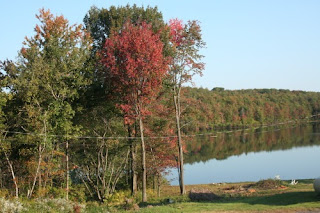 |
| The Judson House |
We are spending our week in the Erie area in the small community of Waterford which is about 10 miles south of Erie and just a couple miles north of Route 6. The campground, Sparrow Pond, is relatively new. Even though it is new, there are tall trees, it’s not just a gravel parking lot. There are back-in and pull-thru sites and also a few camping cabins. There is a small grocery in Waterford, but a Wal-mart and larger supermarket just 6 miles north at the interstate.
Yesterday, having rested until mid afternoon, we went to scout out Waterford. It is small, but it does have a claim to fame. It was here in 1753 that George Washington carried out his first official mission. George was sent by the Governor of Virginia to tell the French to move on along, they were trespassing on British soil. Perhaps the French felt like they had the right since they occupied the local fort, Fort Le Boeuf. The French finally left in 1759 and the British took over. The Indians didn’t like the British hanging around so they burnt their fort in 1763. Twenty years later the Americans built a fort here to protect the settlers. Today, the Judson House is located on the site of the old French Fort and across the street is a nice little park with the statue of old George.
We also found a terrific restaurant supply store. Since I enjoy cooking, I like places like this. You could get anything for cooking in here, new or used. I have one 9” pizza pan—it’s the individual pizza size. My microwave is also a convection oven but the space is small so my cookie sheets are too large. I use the small pizza pan for many things I prepare in the convection oven. I have been looking for more to use for individual pizzas. I also found a shake making machine. Just think of the fun we could have and the weight we could gain!!
 |
| A great mural in Meadville |
Meadville is not far from here down Route 6 about 20 miles. We woke up to rain this morning so decided to check out the Meadville Market House said to be the oldest “continuous use market in Pennsylvania” having opened in 1870. The descriptions I had read made me think of the farm markets in the Lancaster county area with lots of Amish canned foods, fresh produce, and baked goods. Yummy. We were a little disappointed when we got there. It was not nearly as large as the markets we had visited earlier in the summer, but there was one stand with the last of the tomatoes of the season and some squash and potatoes. There were several booths of handmade craft items, but the artisans were not there—just pick what you want and take it to the cashier up front. All we found of interest was a cup of coffee.
 |
| Meadville Market House |
 |
| Meadville's Village Green |
 |
| Meadville street scene |
Meadville is a sprawling community and much larger than the other quaint villages we have visited. Route 6 is even a 4-lane through here. We walked around in the few blocks near the market and were saddened by the deterioration of this once thriving community. The performing arts seemed to be flourishing, however, and we had great fun with their displays of ghosts and goblins. The village green was also quite nice.
 |
| Hanging out with the ghosts of Meadville |
With the rain clouds getting heavier we made our way home. Perhaps the rain will let up tomorrow enough for a visit to Presque Isle on Lake Erie.
















































